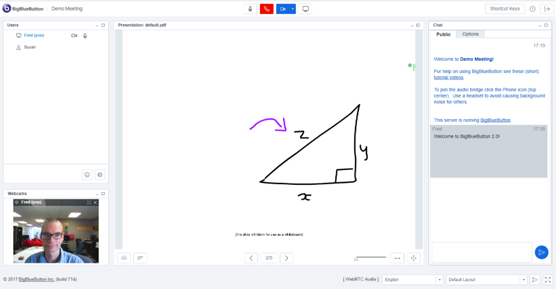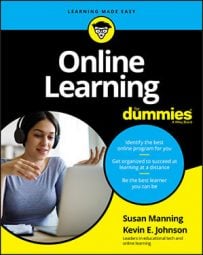Safety concerns with children
We won’t kid you: Having children learn online is a reason for parents and guardians to be concerned about their safety. For starters, children tend to trust everyone and may not have the same sense of boundaries that adults do. Plus, creeps on the internet prey on children.
In the interest of avoiding hysteria, we want to frame some of these concerns with the positive solutions that online schools have put in place:- Online education must be supervised by adults. In the next section, we discuss enhanced parental involvement, and one of the primary reasons for this is to monitor what children do online, where they go, and with whom they communicate.
- Online programs must be password protected with limited access. Institutions establish protocols so that only the students and their adult supervisors can log in to the learning space. Coursework is conducted within that space so that a child has no need to interact with anyone else online.
- Educators who work with children online must pass stringent background checks. In the same way that teachers in brick-and-mortar schools must be blemish-free, online institutions ensure that their faculty are likewise squeaky clean.
With adult learners, the same behavior is possible and disconcerting, but children need to be afforded special protection. (As soon as adults become involved, the language changes to cyberstalking or cyberharassment.) Schools help children understand what is acceptable communication with their classmates and encourage those who experience bullying to report it swiftly. Policies and procedures guide schools in addressing offenders and determining an appropriate punishment.
If your child decides to study online, here are some pointers to keep in mind:
- Talk to your child about expectations. If your child is going to learn or play online, you should talk as a family about rules for engaging online. For example, in Kevin’s family, parents control their son’s contacts list, and their son can engage only with people on that list. Parents also require login and passwords to all accounts, and no new accounts can be created without their permission.
- Beware of false identities. One form of cyberbullying is tricking a person. A student may believe they are communicating with a friend when in fact it’s a false identity. Help your child discern when and what to disclose online. Personal information should be off limits.
- Monitor social networking. Classmates naturally form interpersonal relationships online. Your student may want to communicate with their classmates via email or social networking spaces like Facebook. However, these activities should be monitored by an adult. In other words, if your kid has a Facebook account, make sure you can see what’s going on.
- Report inappropriate activity. If another child posts embarrassing or harassing statements or images, report this to the school officials immediately. It may be out of the range of their ability to discipline, but noting the behavior can have a significant impact on stopping it.
Then again, online schools know the types of behaviors that should be further reported to the police. For example, consider reporting to the police if personal information is involved in a threat against your child. You may hesitate, thinking that the incident is minor, but it’s best to let the police sort it out. Don’t immediately delete the offending messages. The authorities may need to see them.
Whatever you do, don’t retaliate with the same kinds of threats or harmful messages. Getting involved in a verbal tit-for-tat will only result in your child being accused of being a cyberbully. Teach your child to walk away from the computer and cool down before reporting such an incident.
- Block bullies. By all means, block communication with cyberbullies. Email programs and instant message software, such as Yahoo! Messenger, allow you to do this.
For more information about cyberbullying, consult one of these sites: Stomp Out Bullying, the National Crime Prevention Council's site on cyberbullying, or the U.S. government’s Stop Bullying site.
Enhanced parental involvement
In K-12 schools, parent-teacher communication is getting better, with electronic grade books and online learning portals that support the face-to-face classroom. However, direct communication between parent and teacher around specific areas in which a student needs to improve can be difficult based on schedules, student-to-teacher ratios, and communication preferences.Parental involvement is completely different with virtual schools. If you follow any of the virtual school links, you will quickly note that every institution requires greater parental involvement than traditional schools. Parents have access to everything: grades, feedback, and lessons.
Adults who supervise at home are given various monikers by online schools — parent/guardian, home facilitator, and onsite instructional support, to name a few — but their roles are the same. The need for enhanced parental support stems from the age and abilities of the learner.
Here are a few examples of the roles parents must play when their child attends school online:- Because most information is delivered by way of text online, the only way to survive in an online course is to read. That’s impossible for the average 6-year-old! Adults serve as readers.
- Few children are as self-motivated and disciplined as they need to be for online learning. Adults serve as watchdogs and taskmasters.
- Because an online teacher may not see the whole family situation, routine communication becomes more important. Teachers schedule weekly or monthly communication with parents or supervisors, depending on the age of the learner and the structure of the school.
As the child progresses academically, the amount of assistance decreases. By the time a student is in Grade 12 and takes more ownership of the learning process, the adult should be active no more than 1 to 10 percent of the time and not at all instructionally. Instead, the adult’s role shifts toward holding the student accountable while continuing to provide motivation and support.
Any decent virtual school for kids requires parental involvement! Schools tell you this using some of the main links on their web pages — for example, a Parents tab or a link to parental involvement. It shouldn’t be a secret. If it seems obscure, look at another school.
More real-time opportunities
The world of online education for children is more synchronous than their adult counterparts’ experience (in other words, it takes place in real time more frequently). Students may be expected to participate in online meetings daily, weekly, or monthly. These synchronous meetings with instructors and other students reinforce the subject matter, build strong community bonds, and, generally, keep learners on task. Even schools that follow a self-paced model for curriculum usually back up their courses with regular synchronous meetings.Synchronous meetings typically use web conferencing software and call together multiple students in a class. These meetings can be a lot of fun! The teacher may present new information or reinforce what the students are studying. They can ask and answer questions about content or assignments. Perhaps the greatest value of the synchronous meetings is the feeling of interpersonal connection between the student and teacher, which is still vital in virtual education for children. The figure shows what a synchronous interface may look like for an online K-12 course.
Don’t forget that the telephone is a synchronous tool, too! Teachers often call students to monitor progress and talk about what’s happening in class.
 PA Leadership Charter School
PA Leadership Charter SchoolA synchronous class interface
The need to work offline
Surprisingly, not all online education happens online. Although adults can work offline, such work is especially important for younger learners. Young learners need time away from the computer to accomplish academic tasks that involve the following:- Textbooks and workbooks: Can you imagine learning to print numbers without having a pencil and paper in hand? Some early academic tasks have to be done away from the computer screen. Further, at the point when children learn to read for information (around fourth grade), they begin to access materials like books and periodicals offline.
Almost every virtual school uses textbooks. Flashy media may be available online to explain concepts, but online education for young learners also involves print materials.
- Old-fashioned, hands-on learning: Curricula for young learners includes hands-on opportunities to experiment with concepts. For example, a child in an earth science class may be provided with rock samples to examine and evaluate. Or, the child may be asked to collect leaf samples for a botany unit. Exploring one’s natural curiosity is part of learning, and good online curricula requires students to go out in the world and find these key relationships.
When you’re researching online schools, ask how much learning occurs online versus offline. If a program seems especially off balance with no adequate explanation, consider looking at a different school. Kids need balance.

